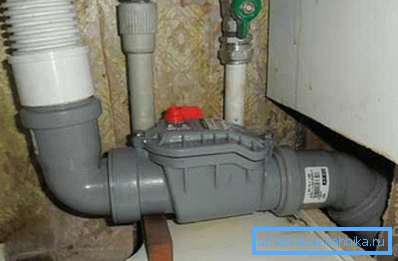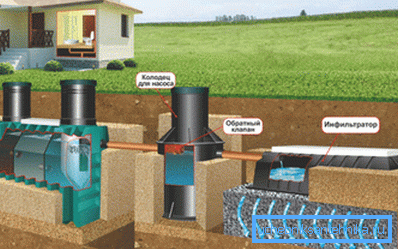How necessary is a non-return valve for sewage, and where
The best indicator of the quality and uninterrupted operation of home sewage is its high throughput. As soon as a blockage forms in any of its points, the polluted drains will not be able to fully drain into the receiving collector, as a result of which the water level will rise and the liquid will flow through the drain holes into the interior of the room. To prevent this from happening, a check valve for sewerage 50 mm is installed at the outlet of each sanitary device, and a check valve with a diameter of 110 mm is installed at the point of connection of the collector to the central riser.

The use of a check valve in the home sewer
In order to sort out in detail the question of why a check valve is needed, this article will look at various models of such devices for use in domestic sewage systems.
In addition, there will be presented a detailed instruction in which the most suitable places for the installation of this device are indicated, as well as all the features of installation and further maintenance are described.

Device assignment
Most of the domestic systems for the collection and disposal of sewage water works on the pressure-free principle, that is, the water inside it moves by gravity, due to the natural slope of pipes throughout the sewer network. If in any place the water encounters an obstacle, its level begins to rise, it fills the entire system and moves in the opposite direction until it finds another way out.
Most often, this exit is located in the ground floor apartment of a multi-storey building or, in the case of a local blockage, in sanitary appliances with a low arrangement of drain holes (bathtub, shower stall).
As is already clear from the name, various models of the check valve are used in sewage systems to prevent the return flow of sewage when adverse conditions occur.
The return flow of water in a pressure-free system, in most cases, can be caused by the following factors:
- Clogging of the sewer system as a result of flushing large debris, food debris, rags, diapers and other municipal solid waste into the toilet. The lower the floor apartment is located in a high-rise building, the more susceptible it is to flooding, due to blockage.

- Failure to comply with the inclination angle of the sewage pipes can also, over time, lead to a decrease in the internal section and the formation of blockage. Too shallow inclination does not provide sufficient water velocity, which is necessary to remove fat deposits and solid particles from the walls of sewage pipes. At the same time, a too steep angle leads to a strong increase in the speed of water at which it cannot take away the garbage, but just washes it, bypassing it from above.
- If the storm or flood and faecal sewage systems are combined into one system, with heavy rainfall or long-term precipitation, a significant rise in the water level is possible, which in the absence of a non-return valve may lead to its entry into the sanitary appliances in the private sector.
- In autonomous systems for utilization of domestic wastewaters, seasonal groundwater level changes as well as flooding of the septic tank during heavy rains or floods can be the cause of reversal of sewage.

Tip! Another argument in favor of the installation of a check valve is that such a device prevents rodents, rats and other pests from the sewage collector from entering the room.
Operating principle
In most cases, check valves are made of metal or PVC plastic, but in household systems plastic models are most common.
Despite the diversity of such devices in its principle of operation, all sewage check valves can be divided into two types.
- The metal flanged ball valve can be made of cast iron, steel or brass.. The locking device in this case is a spring-loaded metal ball, which is located in a sleeve of larger diameter. In normal mode, the water quietly flows past the ball, and in the event of a countercurrent, sewage presses the ball to the valve seat, thereby completely blocking the internal section of the pipe.
- The poppet valve is usually made of rigid PVC plastic and is most often installed in modern sewage systems of polymer pipes.. The basis of his work is a plastic plate with a rubber seal, freely suspended inside the case on a lever hinge. In normal mode, the plate is pressed against the saddle under its own weight and does not interfere with the free flow of wastewater. In the case of fluid retraction, the plate is pressed against the saddle under pressure from the head, and hermetically closes the internal section of the pipe. After reducing the pressure on the retaining side, the plate is released, and the valve automatically switches to normal operation.

Tip! The ease of installation and the low price of protective devices puts their installation in the number of mandatory work in the construction of sewage for owners of apartments located below the third floor.
Installation sites
Sewer check valves are available in various versions and differ in size, flow capacity and diameter of the attached pipes. For complete protection of the sewage system, the installation of check valves is performed at the place of discharge of the horizontal sewer from each individual riser (in the kitchen, in the bathroom, in the bathroom).
In addition, to prevent local overflow of wastewater inside the house or apartment, it is recommended to install an additional protective device at the outlet of each sanitary device.
- For installation at the outlet of various plumbing fixtures (bathtub, sink, shower), a small non-return valve with 50 mm diameter plastic connecting pipes is most often used.
- As a general protective device against the ingress of water from a vertical riser, a reverse sewer valve v115 is used for PVC pipes with a diameter of 110 mm.
- Installing a safety device is also necessary if there is a section with a reverse angle of inclination of sewer pipes in the system. In this case, it is installed at the lowest point of such a section.

Tip! In addition to horizontal collectors, the installation of a protective device is allowed on a vertical riser. At the same time, during installation, it is important to ensure that the arrow on its body matches the direction of movement of the wastewater.
Installation and maintenance
Installing protective devices in an existing sewer system does not present any particular difficulties, and yet, when performing such work, it is necessary to follow simple rules and recommendations.
- The cross-section of sewer pipes and the intensity of the plumbing equipment should be fully consistent with the diameter of the inlet and outlet pipes, as well as the passport capacity of the protective device.
- Before installing a non-return PVC valve for sewage 110 mm, it is necessary to turn off the water throughout the riser of a multi-storey building and, if possible, ask its neighbors not to use water drainage.

- After installing the device, you need to check the tightness of all connections and make sure that there is no vibration of the locking plate or ball. To do this, the system should be provided with a short-term maximum load, visually inspect all the connections and check the device for the presence of vibration.
- To clean the locking plate and valve seat from adhered debris and fatty deposits, unscrew the four bolts on the device body, remove the lid and clean it manually with a sponge or a stiff brush dipped in any detergent.
On the top cover of many such devices there is a special lever that serves to force the closure of the drain pipe, for example, in case of heavy rain, or during scheduled maintenance or repair work.

Tip! It is most advisable to install protective check valves at the same time as installing the entire sewer network during the construction of a house or the replacement of internal wiring.
Conclusion
After reading this article, it becomes clear that by installing a non-return valve for sewage with your own hands, you can safely protect your home from unpleasant consequences in the form of floating fecal matter or the entry of rodents through the sewage system. For more information on this issue, you can watch the video in this article or read similar materials on our website.